
Drowning and Resuscitation Pages: 1 2 3 4 5 6 7 <<First
Resuscitation of Drowning Victims at Sea, Page 7
Resuscitation Methods: Stimulating the Victim's Nose
Similar to stimulating the mouth was stimulating the victim's nose. The only period author under study to recommend this was the earliest: Stephen Bradwell. He advises that after victim's stomach is emptied of water, "it is good to old strong sweet smelling things to his nose (as Muske, Lignum Aloës, or such like) to warme the Braine, and comfort the Spirits"1. None of the other period authors mention stimulation of the nose for revival. Note that there is again a call to warming the patient in Bradwell's comment.
Stimulating the Victim's nose, Post-GAoP
After the golden age of piracy, authors focused more on the irritating aspects of scents applied to the nose. John Wilkinson suggests that "the attendants should endeavour to excite a re-exertion of the vital functions [of the body] by other more powerful incentives: sharp stimulating things may be applied to the more sensible parts, ...[such as the] nose"2.
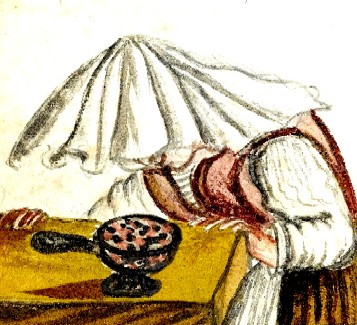
Treatment by Stimulating the Nose, from the Compendium
of Popular Medicine_and Surgery (1675)
Several suggestions were made as to what could be done to "Irritate the internal Fibres of the Nose"3. Wilkinson lists several ingredients including "mustard, ginger, Chian, or other pepper, hellebore, assarabacca [Asarum europaeum], sneeze-wort [Achillea ptarmica], water-pepper, and the like ...and sharp powders or snuffs, or precipitate blown up by a quill"4.
Bruhier d'Ablaincourt recommends a variety of irritants including "volatile Spirits, and the Liquors used in Apoplectic Cases ...or by blowing into the Nostrils, thro' a Quill, Snuff, or some more powerful Sternutatory."5
In one the Dutch society case studies, a surgeon treating a ten year old girl found success through "the repeated use of sal ammoniac, I made her smell of it continually, which refreshed her, and by degrees restored her."6
Wilkinson talks about some other, more physical nasal incentives. He noted having had success by the use of "feathers put up the nose, to irritate it, ..:it may likewise be pricked with pins, lanced, or actually burned with pointed hot irons: but these last are more violent means."7 D'Ablaincourt likewise suggests "tickling the Nerves distributed to the Nostrils by the bearded Part of a Feather"8 but stops short of poking or burning the nose as a means of resuscitation.
Volatile or smelling salts are by far the most popular suggestion made in the Dutch society cases, being used in half of the 22 cases where stimulation of the nose is tried. The second most popular suggestion was tickling the nose with a feather, which is employed in 6 cases. The ever-popular nasal irritant tobacco smoke was tried in 5 cases. The remaining elements are only used in one or two of the Dutch society cases, including balsam vitae, brandy, camphire tincture, salt and pepper, spirit of balm and spirit of hartshorn.
1 Stephen Bradwell, Helps For Suddain Accidents Endangering Life, p.99;2 John Wilkinson, Tutamen Nauticum or The Seaman's Prevention from Shipwreck, Diseases and Other Calamities Incident to Mariners, p. 6; 3 Bruhier d'Ablaincourt, The Uncertainty of the Signs of Death, p. 207; 4 Wilkinson, p. 6; 5 d'Ablaincourt, p. 207; 6 Thomas Cogan, Memoirs of the Society Instituted at Amsterdam in Favour of Drowned Persons for the Years 1767, 1768, 1770 and 1771, p. 25;4 Wilkinson, p. 6; 3 d'Ablaincourt, p. 207
Resuscitation Methods: Mouth-to-Mouth
Of all the methods used during (or near) the golden age of piracy, this is likely the only one most people would think to work. Although none of the period authors cite the procedure we think of today (pinching the nostrils and blowing into the mouth to inflate the lungs), John Pechlin does explain during the revival of the gardener of Trolingholm that, "air [was] blown up his nostrils for several hours, till the blood began to move."1 Given this scant description, it could be argued that this may not have been a form of inflating the lungs by another person. However, the successful outcome may indicate otherwise.
Mouth-to-Mouth, Post-GAoP
Scottish surgeon William Tossach uses the more widely recognized procedure, which he used while treating an aspyxiated miner on November 11th, 1732. Tossach described his method quite vividly. I have inserted a paragraph break for readability.
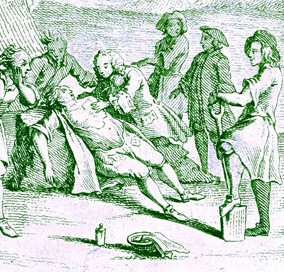
Artist: Jacques-Benig Winslow
Artificial Respiration After the Incident on 11 Nov
1732, Described by W. Tossach (1746)
I applied my Mouth close to his, and blowed my Breath as strong as I could, but having neglected to stop his Nostrils, all the Air came out at them; wherefore, taking hold of them with one Hand, and laying my other on his Breast at the left Pap [nipple], I blew again my Breath as strong as I could, raising his Cheft fully with it, and immediately I felt six or seven very quick Beats of the Heart; his Thorax continued to play, and the Pulse was felt soon after in the Arteries.
I then opened a Vein in his Arm, which, after giving a small Jet, sent out the Blood in Drops only, for a Quarter of an Hour, and then he bled freely. In the mean time I caused him to be pulled, pushed and rubbed, to assist the Motion of his Blood as much I could, washed his Face and Temples with Water, and rubbed Sal volatile [smelling salts] on his Nose and Lips.2
Knowing what we do today, the mouth-to-mouth probably did far more to resuscitate the patient than any of the methods mentioned, but I have included them to show how anything and everything was tried, making the identification of effective, working resusication methods difficult to distinguish.
John Wilkinson recommended the use of mouth-to-mouth in his book. He naturally ties this procedure's sucess to his belief that it somehow aids the circulation. Wilkinson provides some curious additions to the routine.
A Wholsome strong person ought to blow warm air into his lungs; and [Physician Samuel-Auguste] Tissot says, even fumes of tobacco, if that can be done; which may be effectuated by means of a pipe, funnel, faucet, reed, cane, hollow stick, quill, or the like tube introduced into the mouth. This air blown forcibly, the nostrils being stopped at the time, will make its way into the lungs, and by its warmth rarify the air, which mingled with the water forms that froth by which the respiration has been obstructed; and, being disengaged of the water, it may escape. By this introduced air, the lungs are dilated, and, if any life remains, the circulation immediately recommences.3
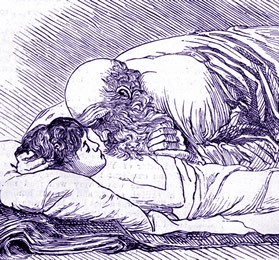
Artist: Reginald Hallward
Elisha Resuscitating a Shunamite Boy by
Artificial
Respiration (1881)
In a similar manner, Dr. Francois Vicentini explains in Cogan's book that, "Since the passage of blood through the lungs is stopped for want of respiration, it is necessary to blow fresh air into the lungs."4
Doctor John Fothergill, commenting on the Tossach case in 1746 has a slightly different theory from that of Wilkinson and Vincenti about why mouth-to-mouth resuscitation works. "Inflating the lungs, and, by this means, communicating motion to the heart, like giving the first vibration to a pendulum, may possibly, in many cases, enable this something to resume the government of the fabric, and actuate its organs afresh, till another unavoidable necessity puts a stop to it entirely."5
Alexander Johnson includes Tossach's case in his book, giving a very abbreviated account.6 In his recounting of the Dutch cases, Johnson tells of the surgeon Durandus Bontjes who revived a young boy. Johnson says that the surgeon in that case "ascribed the success of his treatment chiefly to his art of blowing wind in at the nostrils, whilst he held the mouth and lips close; a discovery [he earlier had made], by means whereof he said he had quickened a child, that seemed dead at its birth."71 John Wilkinson, Tutamen Nauticum or The Seaman's Prevention from Shipwreck, Diseases and Other Calamities Incident to Mariners, p. 2; 2 Bruhier d'Ablaincourt, The Uncertainty of the Signs of Death, p. 81-2; 3 Wilkinson, p. 5; 4 Thomas Cogan, Memoirs of the Society Instituted at Amsterdam in Favour of Drowned Persons for the Years 1767, 1768, 1770 and 1771, p. 25; 5 Charles Hutton, George Shaw & Richard Pearson, The Philosophical Transactions of the Royal Society of London, Vol. IX From 1744 to 1749, "Observations on a Case published in the last Volume of the Medical Essays, Edin. 1744, &c. of Recovering a Man dead in Appearance, by distending the Lungs with Air. By John Fothergill, M.D., p. 275 6 Alexander Johnson, A Short Account of a Society at Amsterdam Instituted in the Year 1767 For the Recovery of Drowned Persons, p. 118; 7 Johnson, p. 72
Resuscitation Methods: Persistance (Post-GAoP)
Although not a resuscitation method in and of itself, persistance is mentioned by some of the authors writing about resuscitation after the golden age of piracy. Thomas Cogan advises "since no body can affirm with certainty that the drowned be really dead, unless there be some signs of putrefaction on the body, we hope that till then all possible efforts may be made"1.
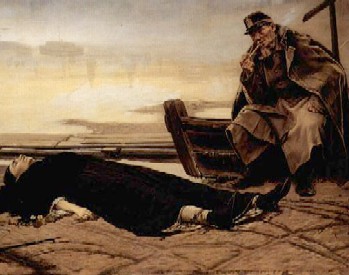
Artist: Vasily Perov
Die Ertrunkene - The Drowning (1867)
Putrefaction is decomposition of the body. While it is unclear just what sort of putrefaction Cogan is referring to, in most cases this could take days to recognize!
John Wilkinson is particularly vocal about resuscitation efforts continuing for an extended period. Among his list of methods for resuscitation, he recommends that efforts "must not be discontinued so soon as the Drowned begin to shew signs of returning to life; for sometimes they die, after some faint tokens of recovery; therefore we should persevere in our good endeavours."2
Wilkinson also warns that the resuscitator should "not be discouraged though many of their attempts may have proved ineffectual; for there have been numerous instances of Drowned Persons (who were attended by such valuable people as would exert themselves on the occasion) being happily restored to life, though they had appeared to be dead for five or six hours, and though many means had been tried before they began to shew tokens of returning life."3 It will probably seem amazing to us that anyone would have the stamina to continue attempting resuscitation of a drowning victim for five or six hours, but we must remember that methods of resuscitation included all of the nine strategies discussed previously, many of which required minimal action on the part of the person attempting to revive the drowned.
1 Thomas Cogan, Memoirs of the Society Instituted at Amsterdam in Favour of Drowned Persons for the Years 1767, 1768, 1770 and 1771, p. 4; 2 John Wilkinson, Tutamen Nauticum or The Seaman's Prevention from Shipwreck, Diseases and Other Calamities Incident to Mariners, p. 8; 3 Wilkinson, p. 6
Post-Revival Treatment
Some of the period surgeons and physicians talked about treatmen after a drowning victim was revived. Our two sea surgeons each pointedly refer to bleeding the victim. John Moyle advised that when "the Man should be bruised in the fall [into the water], then open a Vein, and give him either the Traumatick Powder, or Haustus [a draught or potion], mixed with burnt wine [brandy]."1 John Atkins likewise suggests that on the next day "if there be any Complaint of a Bruise, Hurt, or any Pain affecting the Belly or Breast, Bleed, give a Bolus
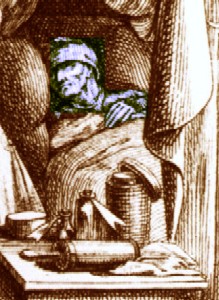
From Medizinische Annalen fur Aerzte und
Gesundheitliebende, frontispiece
by Johann Gottlieb Frietze (1781)
[clyster or enema] of Sperm. Cæti. [spermaceti - a wax found in the head cavities of the sperm whale] and Ther. Adrom. [Theriaca andromachi aka. Venice Treacle] continuing the Patient afterwards to good Broths and the traumatick Powders and Decoctions of Bates or Fuller [compound medical nostrums]"2
Both of these prescriptions are clearly wound treatments which are only tangentially related to drowning. Their primary goal is probably to remove the bad humors from the wound and provide a diet and regimen of medicines that will generate good humors in the blood.
Stephen Bradwell had a great deal to say about the diet the nearly drowned should adopt upon being revived. This makes sense given his rather down-to-earth approach to medicine and his rural audience.
If by these meanes he recover life, sense, and speech; let him (some two houres after) eat some meat of a hen or chick (if he be able) or els suck the juice of them; and let them be roasted or broiled, rather than any other way dressed.... And with his meat, let him eate Pepper and Sugar, or Pepper and Honey, as he liketh best. He may also eate a roasted egge with pepper in it. But let him not drink at all in 24. houres at the least, & then let it be middle-Beere and white wine mixed together; of which let him him drink but 2. small draughts at a meale, and betwixt meales not at all. This Diet let him observe for a weeke together, keeping himselfe warme and moderately stirring his body immediately before, & an houre after his meate.3
It is interesting that he advises against the recovering victim drinking any liquids for a day, given that both Atkins and Moyle suggest soups and liquids.
1 John Moyle, Abstractum Chirurgæ Marinæ, p. 99; 2 John Atkins, The Navy Surgeon, p. 269; 3 Stephen Bradwell, Helps For Suddain Accidents Endangering Life, p.99-100
Going Down for the Third Time
Last, but almost certainly least, is a quote I found in one of the Dutch society cases that I just had to talk about before leaving this topic. Alexander Johnson relates the following tale: "A Journeyman Shoemaker, in Reading, as he was washing in the Kennet, near Blake's bridge, fell into a hole out of his depth;
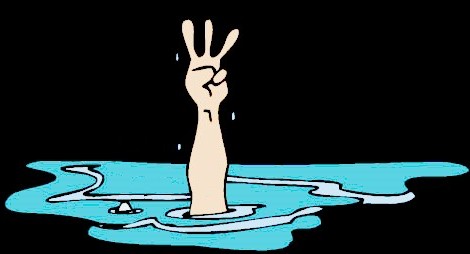
and he could not swim, he struggled some time, then sunk under water, but rose three times, as is said to be usual, and as often sunk to the bottom."1
I found it interesting that the old wives tale about sinking three times before drowning was written about in 1773. Most people today are probably not familiar with this hoary chestnut; I probably wouldn't be aware of it if it weren't for my love of old cartoons.
For those tempted to believe this is true, writer and myth debunker Cecil Adams explains that "it's true that in most cases of drowning there is a fairly predictable predeath scenario, to wit: (1) panic, violent struggle; (2) attempts at swimming; (3) apnea, or breath-holding, during which time the victim often swallows large amounts of water; (4) vomiting, gasping, and inhaling (as opposed to swallowing) of water; (5) convulsions; and finally (6) death. To the extent that "going down three times" is a crude folk attempt to describe the preceding process, there's a germ of truth in it. But it's not literally accurate."2 He also notes that cartoons "are not normally regarded as a source of reliable medical insight." (I personally take umbrage at that one.)
1 Alexander Johnson, A Short Account of a Society at Amsterdam Instituted in the Year 1767 For the Recovery of Drowned Persons, p. 110; 2 Cecil Adams, "Do you "go down three times" before drowning?", The Straight Dope, May 25, 1984, gathered from the internet 2/24/14; 3 Adams, The Straight Dope

